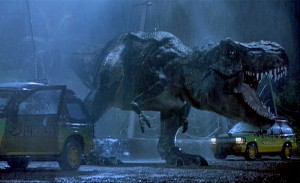Dinosaurs, as you like them In Focus by Richard Crouse METRO CANADA July 03, 2009
 Movie dinosaurs come in all forms. As screen characters — from Jurassic Park’s terrifying T-Rexes to the cute and cuddly baby dinos of this weekend’s Ice Age: The Dawn of the Dinosaurs — they are as versatile as they are extinct.
Movie dinosaurs come in all forms. As screen characters — from Jurassic Park’s terrifying T-Rexes to the cute and cuddly baby dinos of this weekend’s Ice Age: The Dawn of the Dinosaurs — they are as versatile as they are extinct.
Just as varied are the methods used to bring the prehistoric behemoths to big screen life.
The first film dinosaur was a pen-and-ink creature seen in a fanciful 1908 British film called Prehistoric Man. In it a caveman sketch comes alive and threatens its creator. The artist survives by drawing a picture of a dinosaur, which also comes to life and eats the prehistoric man.
Another of the original celluloid dinosaurs was Gertie the Dinosaur. Released in 1914, the film featured 10,000 hand-drawn images to animate the tango-dancing Apatosaurus.
After Gertie, pen and ink animated dinosaurs remained popular for the next seventy years in everything from 1915’s Stone Age Adventure to 1988’s Land Before Time.
The word dinosaur means “fearfully-great lizard” so it makes sense that lizards have frequently subbed for their vanished cousins on celluloid.
A 1914 film called On Moonshine Mountain tried to pass off geckos as dinosaurs while 1940’s One Million B.C. dressed up lizards with cardboard fins for a more “realistic” dinosaur appearance. D.W. Griffith tried for a more menacing look, using an alligator dressed up as a dino for his two-reeler Brute Force, which described the great beasts as “one of the perils of prehistoric apartment life.”
Other methods of crafting on-screen dinos include the old “man in a rubber suit” trick (pioneered by cheapo producer Roger Corman in Voyage to the Prehistoric Planet but perfected by Toho Studios in the Godzilla films) and the wondrous stop motion animation of Willis O’Brien (The Lost World) and Ray Harryhausen (The Beast from 20,000 Fathoms) but the biggest and baddest show biz dinosaurs sprung from the mind of Steven Spielberg (and the computers of his animators).
Even though Jurassic Park’s binary code velociraptors and triceratopses weren’t biologically accurate and didn’t exist during the Jurassic days (most didn’t live until the Cretaceous period) they were the loudest and proudest dinos the movies had ever seen.
Hundreds of films have featured dinosaurs and audiences never seem to tire of them, but why?
“Perhaps people’s fascination with prehistoric life has something to do with bridging fantasy with reality,” offers Harryhausen. “They are connected with the shadowy key to our mysterious origin.”
Leave a Reply
You must be logged in to post a comment.
